Northern, Eastern, and
Southern Woodlands
I. What is the Northern woodlands? The
vast inland areas of North America once covered by the
Great North Woods located between the Eastern seaboard,
the arctic timberline, the Gulf of Mexico, and the
Mississippi River.
A.
Northerners feasted on wild rice, berries, moss, bark,
caribou, elk, moose, small game, waterfowl, turkey, fish.
B. Easterners and Southerners ate corn, beans, pumpkin, berries, maple
sugar, fish, deer, beaver, small game, waterfowl, turkey.
Grew tobacco.
C.
Vast forests of mixed deciduous hardwoods (white birch
favored) which produced strong, light-weight poles and
sheets of bark for construction and domestic uses.
Cedar bark woven into mats in the north.
D.
Lots of water, main transport routes were waterways. When there were no
connecting waterways, they carried their lightweight, birch-bark canoes
overland to the next navigable waterway. In this way they taveled
hundreds of miles.
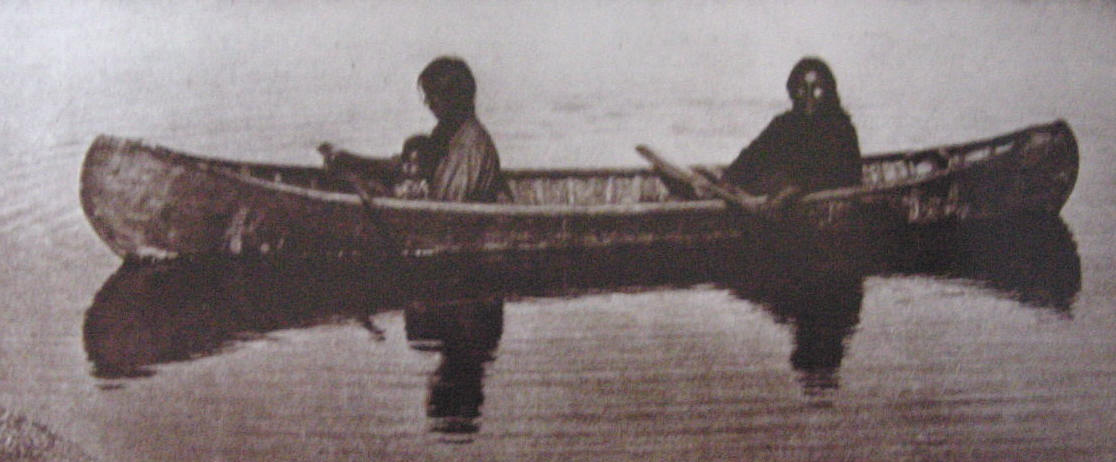 |
| If you look carefully
you can see the poles that make the frame of this canoe, you can
also see the texture of the bark that creates a watertight skin for
the canoe. While on a trip, if a hole should be torn in the
canoe, all one had to do was find a birch tree (they were everywhere
there was water) and create a patch. If you look even more
closely, you can see a small child in the lap of one of the women
paddlers. |
II. Who were the archaic residents of the
Northern Woodlands?
A.
Earliest people we know of lived 2,000 B.C. - 500 A.D.
1.
Made birdstones which are
hard to date because few have been excavated in situ.
a. 6”
long.
b.
Purpose as handles, weights, “magical” handles?
c.
Carved of stone, holes in the bottom index of age.
d.
Frequently counterfeited.
B.
Adena culture thrived c. 800 B.C. - 200 A.D.
1.
Centered in the central Ohio River Valley.
2.
Wattle and Daub architecture.
3.
Indirect (?) trade with people on Lake Superior (copper),
Gulf Coast (shell), Arkansas (flint), Rockies (obsidian),
Tennessee (mica).
4.
Known for platform pipes, only 1 known anthropomorph.
5.
Werepeople practiced arts of
transformation.
6.
Slate tablets with unknown meaning/significance.
a.
10” x 10” x 3/4”.
b.
Designs emphasize curvaceous lines and birds of prey.
7.
Serpent mound is not a burial mound, but function
obscure.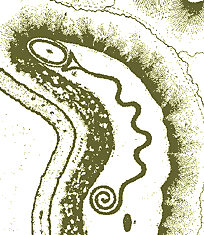
a.
Dimensions: 1,330 feet long; averages 3'h.
b.
What is it?
i.
Rain charms?
ii.
Serpent with horns?
iii. Evil water inhabitants?
c.
Symbol of reincarnation (shed skin).
d.
Reconstruction and plowing obscure true base.
C.
Hopewell c. 300 B.C. - 600 A.D. Mississippian mound builders perhaps
evolved from Hopewell culture and are ancestors of Creek,
Choctaw,
Cherokee, Chickasaw.
1.
Started in Illinois but moved into Ohio River Valley.
2.
Mound city near Chilcothe. Both structural and burial mounds were grouped in
communities of 100 -10,000 people.
a.
Structural mounds supported housing and temple complexes
for the chieftain/ruler.
i.
Largest structural mound covered 16 acres. 14 million
bushels (35lb.) to build.
ii. Topped by
thatched buildings.
iii. Borrow pits.
iv. Overbuilt in waves for 500 years.
aa.
Brings honor to participate in building, like a cargo.
3.
Mounds were used to raise the earthly sun toward the
heavenly sun to make communications easier (Natchez).
4.
Mound tops were above the forest canopy.
5. Burial mounds contain laid-out, folded, cremated,
reburied. internments.
a.
One burial mound contained more than 250 individuals.
b.
Occasional co-interments which may indicate sacrificial
killings, ie. 1 man surrounded by four men and two
children and 54 women.
i.
Arthritis in elbow vs. wrists.
c.
Many objects found within tombs:
Two-dimensional art - sheet mica and sheet
copper
effigies, pearls, shell beads, ceramic pots, pipes, stone
bowls, shell gorgets and cups. 4”
animal pipes in naturalistic form.
i. Objects “killed” when owner died.
d.
Mangled corpses and partial bodies have been found in
burials, perhaps captives or enemies?
e. Mica-lined grave, completely
lined.
6.
Most sites stockaded or dry moated.
a.
Stockades constructed of poles sunk upright in the earth
and lashed together to provide horizontal stability.
b.
Stockades were covered with daub. This made them
fireproof.
c.
Upper classes lived inside enclosures. Stinkards
lived without.
7.
Most sites surrounded by agricultural fields.
a.
Cold tolerant corn, gourds, local squash and pumpkin,
beans, tobacco, sunflowers.
8.
Evidence of astronomical earthworks.
a.
Ring mounds notched for solar and stellar observances.
b.
Axial layouts of sites correspond to our compass points.
9.
Major sites are found in the Mississippi River Drainage
from MN to OK to GA, MS, and AR to the Atlantic and Gulf
coasts, to the great Plains.
a.
Cahokia, IL. largest metropolis north of Mexico.
i. Monk's Mound largest mound
structure, perhaps in the world. more than 100 feet high (above trees), 16
- 23 acres in area.
ii.
North south orientation of site. Solstice and stellar
cycles marked.
iii.
Stone worked as points and blades, pipes and statuary.
iv.
Big time importation of alligator teeth, shark and
barracuda jaws, pink conch and scallop shells.
v.
Cold hammered copper and silver plates, gorgets, ear
spools, and other jewelry.
vi.
Shell objects and products.
b.
Etowah, GA. easternmost site.
i.
Finest ceramic sculptures, exquisite marble statuary.
ii.
Most eastern major site.
c.
Moundville, AB.
i.
Second largest center. Population five times larger than
pre agri days.
ii.
Carved stone effigy bowls, crested wood duck?
iii.
Incised ceramic beakers and death-mask jars.
vi.
Borrow pits flooded and stocked with fish.
d.
Natchez
i.
Maintained cultural customs and social classes until
1731, massacred and sold into slavery by French.
aa. "Suns" were ruling class.
bb. Ruler carried on a litter by 8 men.
Worn crown of swan feathers. His feet must
never touch earth, his hands should be idle.
Last royal family sold into slavery. All died
in the Dominican Republic on a sugar plantation.
cc.
"Stinkards" are the lower class. For them it was
a cargo to serve the royals.
e.
Spiro.
i.
Charnel house culture.
aa. tomb burned to the ground, covered with earth.
ii.
Ceramic pipe of a warrior clubbing a victim’s face.
iii.
Conch shell cups, incised with the Peals Falcon Duck Hawk
eye mark.
vi.
Some shell "gorgets" may have been spinners which 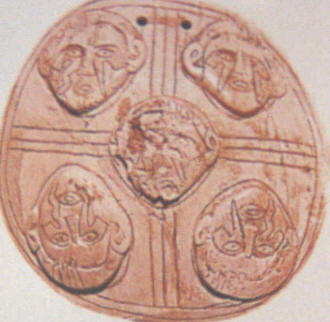 produced a loud whistling sound.
Some, like this one, appear to be drilled for use as a
pendant of some sort, judging by the positioning of the
holes; maybe this one had a very eccentric orbit which
gave it an unusual sound. The wear pattern between
the two holes suggests it may have been sewn to something
else.
produced a loud whistling sound.
Some, like this one, appear to be drilled for use as a
pendant of some sort, judging by the positioning of the
holes; maybe this one had a very eccentric orbit which
gave it an unusual sound. The wear pattern between
the two holes suggests it may have been sewn to something
else.
D.
Traits shared with Mexico.
1. Ceramic sculptures.
2. Three sisters.
3. Mound structures topped with temples and
palaces.
4. Highly developed, wide-reaching trade
routes.
5. Society highly structured by class.
6. Ear spools.
7.
Transformative shamanism.
III. Who were the historic people of the
Woodlands?
A. Three regions Subarctic, Eastern, and South.
1. Subartic - Athabascan
speakers.
2. Eastern
- historically, largely Algic (Algonkian, Iroquoian) speakers.
a.
Pocahontas
and Squanto well known. Hiawatha immortalized
through poetry.
b. Cayuga, Cherokee,
Chickasaw, Cree, Delaware, Erie,
Fox, Huron, Iroquois, Ojibwa, Oneida, Onondaga, Massachuset, Menominee, Micmac, Mohawk,
Penobscott,
Pequot, Powhattan, Sauk, Seneca, Tuscarora, Winnebago, many, many more.
3. Southern - Muskogeean
(Creek) speakers
a. Apalachicola,
Attacapa, Biloxi, Caddo, Calusa, Catawba, Southern Cherokee, Choctaw, Lumbee,
Mayaimi, Mikasuki, Muscogee (Creek), Natchez, Pamlico, Pascagoula, Pee
Dee, Pensacola, Quapaw, Seminole, Timucua, and a hundred more!
B.
Rivers and lakes, not trails, allowed frequent, easy
travel and a resultant cultural homogeneity noticeable in art.
C.
Relatively few artifacts left.
1. Burning associated with epidemics.
2. Natural deterioration and/or weathering.
D.
Many modern sites carry Algonquian or Muscogee names.
1. Pontiac,
Massachusetts, Delaware, Mississippi, Lake Cayuga, Biloxi, Quantico, Seneca
Falls, Minnesota, Natchez, Tuscaloosa, Tuscarora, Oneida,
and hundreds more.
E.
Life ways.
1. Hunted by crossbow,
sinew-backed bow and arrows, weirs, harpoons, calls,
traps, deadfalls.
a. Farther south only weirs, calls,
traps, sinew-backed bow and arrows, self bow.
2. Exploitation of forest flora for food
and medicine and dyes. Maple syrup; sweet potato;
pecans; walnuts; black, blue, cran, elder, rasp, and
gooseberries; grapes; and currants. Agriculturalists as far
north as New England, too.
a.
Three sisters. Tobacco.
3. Great borrowers of Mexican lifeways.
a. agriculture, the ball game, ceramics, featherwork, important
architecture located atop mounds (pyramids).
4. Great inventors.
a. crossbow, snowshoe, maple syrup, birch-bark canoe, lacrosse,
moccasin, toboggan, porcupine-quill embroidery, stockades, longhouse.
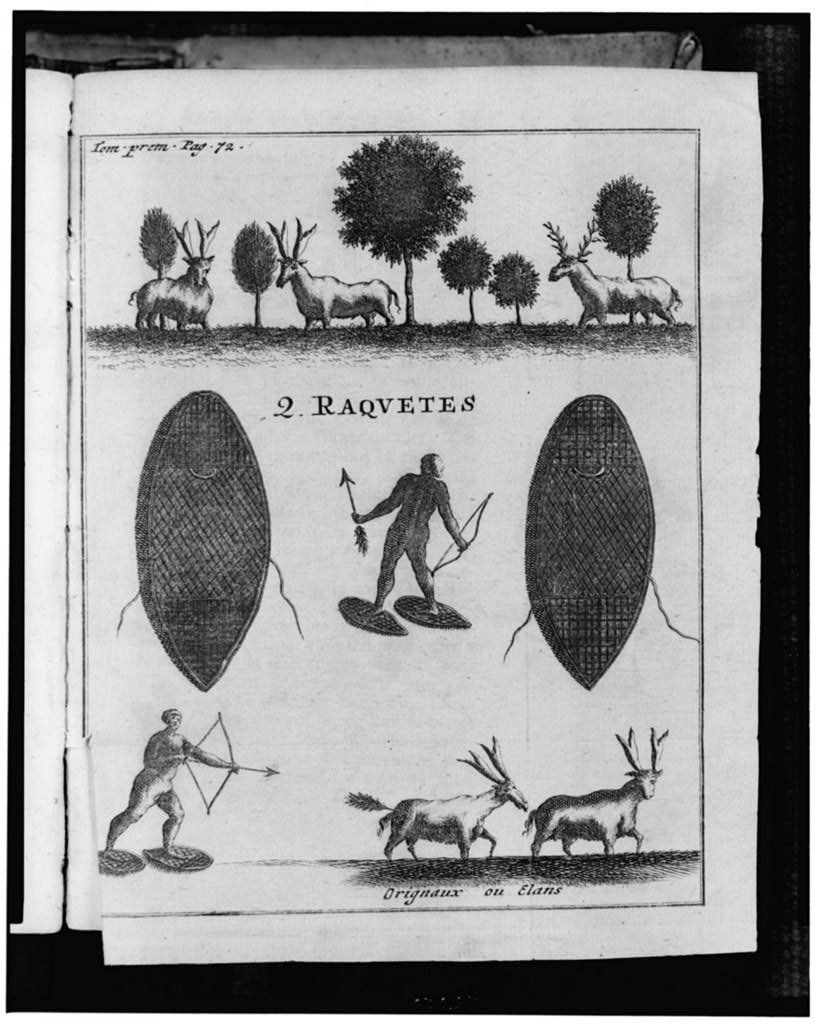 |
| Snowshoes were invented
by the Woodlands people for winter travel and hunting. |
C.
Architecture
1. Northerners
houses were conical bark or hide tents, bark lodges, sweat lodges,
menstrual-segregation houses.
2. Easterners used domed
wigwams,
longhouses, community lodges, too. Engravings by early
European engravers depict houses of spruce, elm, birch.
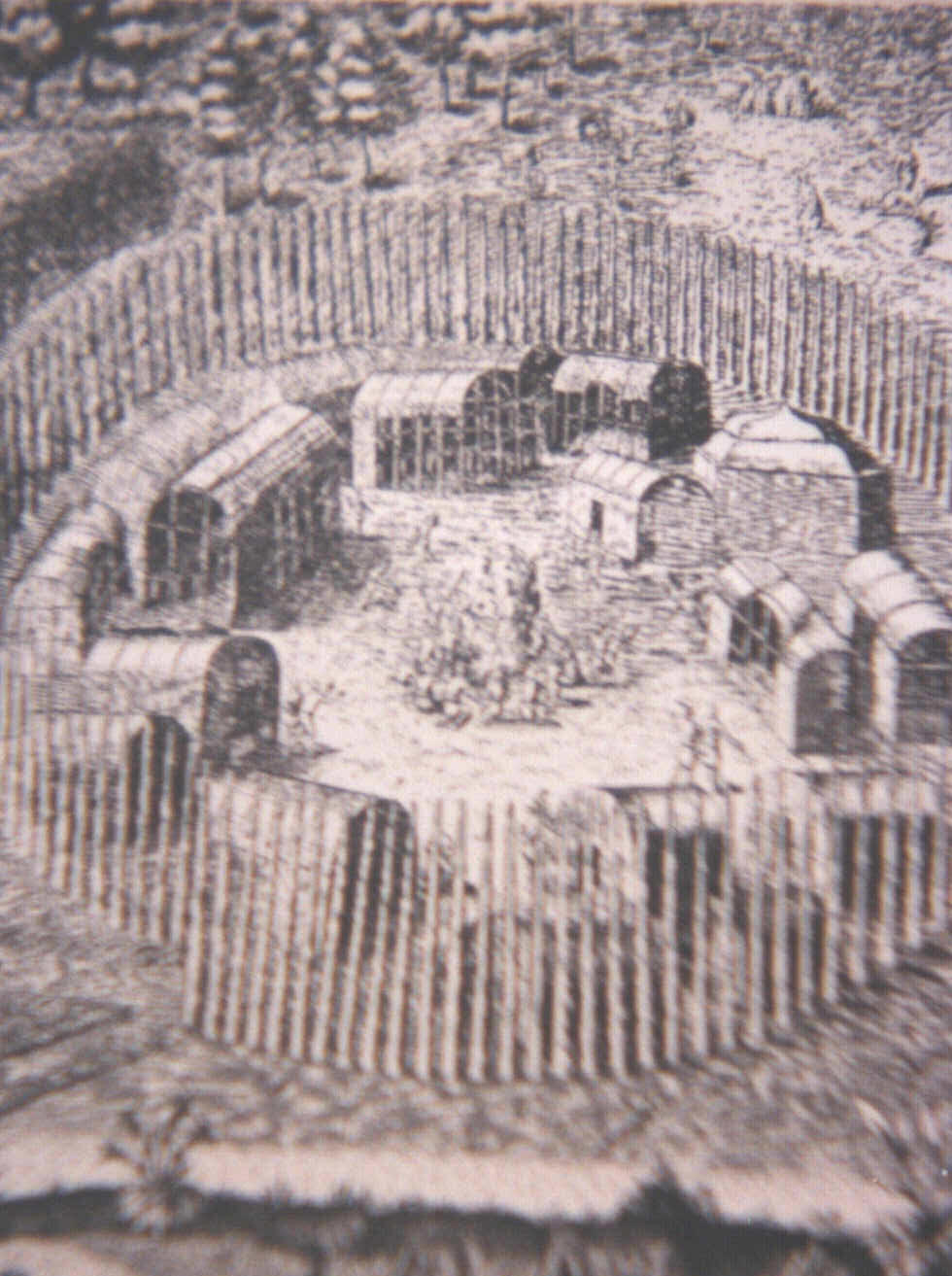 3.
Stockades common north and south.
3.
Stockades common north and south.
D.
Material culture objects include bark containers, bark
foldings, quill work, wooden containers, pottery, clothes, bags,
wampum belts, weapons, masks, patchwork.
1.
Bark containers held dry materials.
a.
Patterns created by finely incising a perimeter and the
subsequent peeling of thin layers of bark within or
without the perimeter.
b.
Emphasis on floral patterns, perhaps of European
introduction.
2.
Bark folding was art for art’s sake. Patterns chewed in.
3.
Quill work (bird and porcupine) was applied to every
surface from boxes to shirts.
a.
Practiced in the extreme northeast.
b.
Usually used porcupine quills, also a fair number of bird
quills.
c.
Micmac quilled boxes for personal storage from 6” to 1’
wide.
d.
Colors more brilliant than Plains quill work, black dye
tough so maidenhair fern root substituted.
4.
Clothing was embellished with quills, moose hair
embroidery.
a. Men wore clothing
of hide.
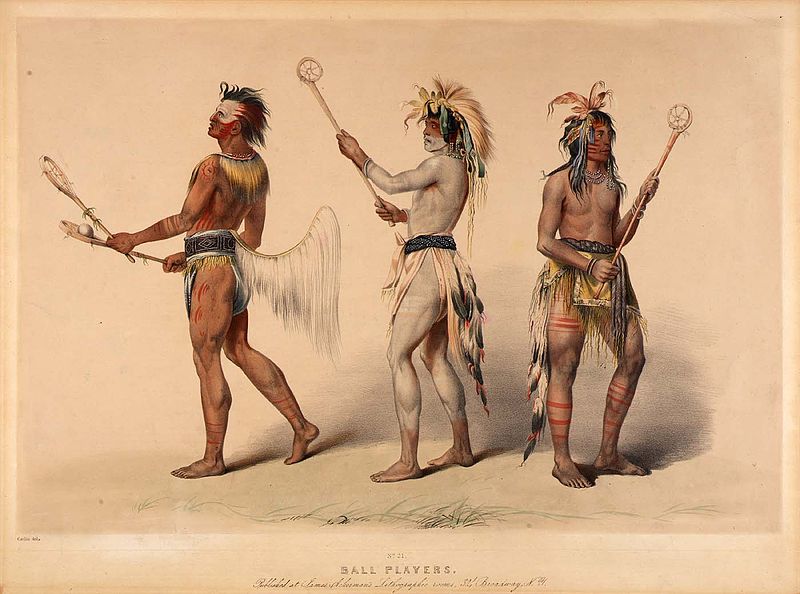 |
| Cherokee Lacrosse Players as painted by G.
Catlin. |
i. breechcloth
ii. leggings
iii.
moccasins
iv. painted bodies and
faces
v. robes or hide serape
and mittens in cold weather.
vi. hair parted in
the center
b. women wore
clothing of hide
i. hide skirt and blouse
ii. leggings
iii. moccasins
iv. painted faces and hair
part
v. robes and mittens in cold weather
c. decorations
i. A
black ground was preferred especially for bags and
moccasins and mittens/gloves. Hide was darkened by
smoking with balsam wood.
aa.
Black trade felt adopted upon introduction. Gloves
appeared with Europeans. Natives used mittens.
ii.
Vining floral patterns predominate but maybe only in the last 500 years.
5.
Beads were used for decoration, currency, recording
historical moments.
a.
Wampum
=
longitudinally-perforated cylindrical bead, white (conch)
and purple (Quahog clam). Algonquian for “ cylindrical
shell bead.”
 |
| This is a diagram of a
wampum bead. It is made of shell and has a hole drilled through the
center. |
i.
Diplomatic and ceremonial use among tribes.
ii.
Dutch tried to monopolize production to control economy.
aa. They brought counterfeit white wampum from Indonesia.
iii.
Adorned persons, given as gifts, served as currency.
iv.
Belts of Huron manufacture given to Jesuits are in
Charters Cathedral.
b.
Fresh water pearls highly valued.
6.
Weapons included club, tomahawk.
7.
Highly sophisticated use of broadcloth, once introduced
by Europeans.
a.
Broadcloth simply means that the looms cloth was made
on went from being made as wide as a home-based could
accommodate to that as wide as a factory could
accommodate, in some cases from 1 meter wide to two
meters wide.
i.
Clothing for dances and ceremonies cut from
broadcloth.
ii. Used as a base with other materials
attached to it.
iii. Cut and resewn as
Seminole patchwork.
8.
Octopus Bags.
a.
A bag with a wide strap worn across the shoulder and
chest.
i.
Used to carry provisions and tools.
ii.
Plastic, so records change rapidly.
9.
Pottery.
a. Borrowed from Mexico.
i. Paddle and anvil method.
ii. Made where clay occurred naturally.
iii. polychrome and plain ceramics produced.
IV. The Iroquois Confederacy was formed
of five original groups (Onondaga, Seneca, Oneida,
Mohawk, Cayuga) who later allowed the Tuscarora
(immigrants from North Carolina seaboard) to join.
In Upper tiers of New York and southern Canada.
A.
Have aggressively pushed forward in the courts for
repatriation and equity.
1. Efforts include requesting that photos of masks
no longer be published.
2. Have recovered major wampum belts.
3. Courts returning lands and forcing American
government to honor treaties.
B.
Retained a good deal of land, tradition, language.
Things to be returned include:
1.
False-face society masks.
a.
First mask collected 1849 (William Fenton), may be
recent?
b.
Used in ceremonies by blowing ashes on invalid.
c.
Masks carved on a living tree (bass, pine, maple) with
many rituals.
i.
Apology ritual recognizes symbiosis.
ii.
Blowing ashes into houses of ill.
iii.
Trees were fed.
d.
Males wore masks.
i.
Dancer who represents the Shaman pounds the earth with
his feet. In the day time Shaman’s face is red, at
noon and during the night his face is black.
e.
Hair made of horse hair; pounded sheet metal eyes, lips,
teeth.
f.
Features emphasized are the distorted mouth (lends mood),
the elongated face, exaggerated features, bug eyes.
g.
Rattle used by shaman in this mask made of turtle shells.
i.
Tells the story of the Creator and the Great Shaman.
aa. Shaman controls game, high winds, disease.
bb. Story says: Shaman followed Sun to the edge of
the world although advised not to. For this he was
banished and became the Shaman of the World Rim.
Shaman was huge and used a full size pine tree for a
staff. The Shaman has a distorted mouth because he
challenged the Sun to a contest. The task was
to move a mountain. The shaman of the World Rim
agreed to go first. The Shaman did move the
mountain with much time and effort and sweat.
Shaman was gloating and taunting the Sun to do as
well as he had. Shaman arrogantly stood in a dramatic
leave taking preparation, turned with a flair, and
smashed his face on the mountain the Sun had, in a
twinkling, placed behind the Shaman.
2.
Corn-husk masks.
a.
Not associated with curing.
b.
Recall introduction of agriculture from “folks on the
other side of the world.” Recalled in dismal and
difficult times (dead of winter).
c.
Braided construction with flaring edges.
d.
Tamale nose.
e.
Used in hard times.
3.
Forest character masks not common now.
a.
Naturalistic renderings of foxes, for ex.
4.
Wampum belts.
Return to Grandmother
Ariadne's Web

 produced a loud whistling sound.
Some, like this one, appear to be drilled for use as a
pendant of some sort, judging by the positioning of the
holes; maybe this one had a very eccentric orbit which
gave it an unusual sound. The wear pattern between
the two holes suggests it may have been sewn to something
else.
produced a loud whistling sound.
Some, like this one, appear to be drilled for use as a
pendant of some sort, judging by the positioning of the
holes; maybe this one had a very eccentric orbit which
gave it an unusual sound. The wear pattern between
the two holes suggests it may have been sewn to something
else.
 3.
Stockades common north and south.
3.
Stockades common north and south.
